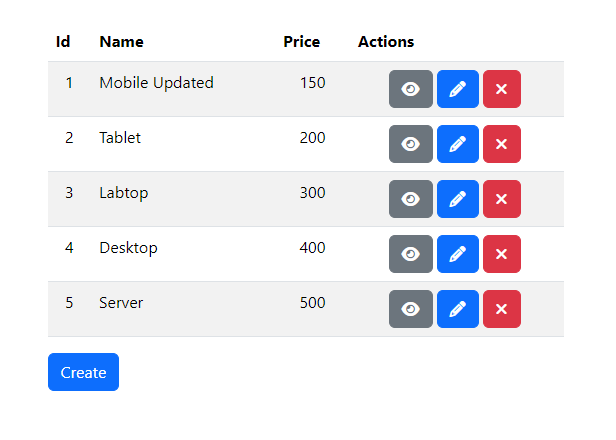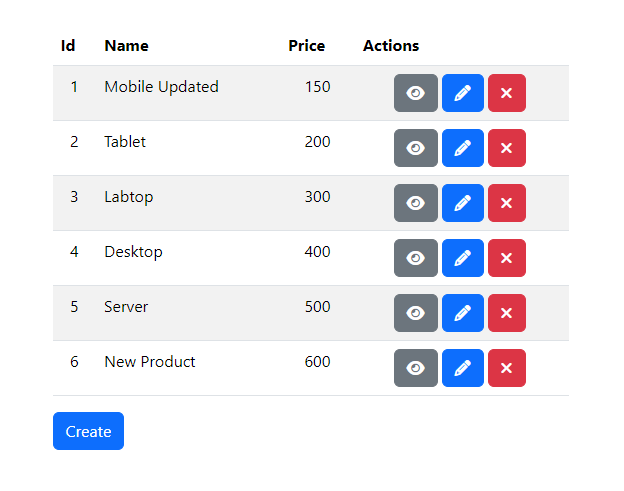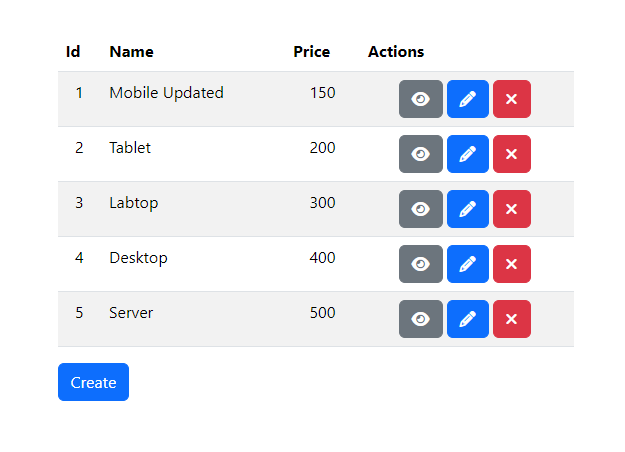
Building a Vue CRUD App with a Laravel API
CRUD operations are fundamental to any web application. In this guide, we’ll show you how to create a CRUD application using Vue for the front end and a Laravel API for the back end, providing a step-by-step approach to integrating these frameworks.
Prerequisites
- Node.js
- Composer
- PHP 8.2
- MySQL
Setup Vue project
npm create vite@4.4.0 view -- --template vue
cd view
npm install vue-router@4 axiosVue project structure
├─ index.html
├─ public
│ └─ css
│ └─ style.css
└─ src
├─ App.vue
├─ components
│ └─ product
│ ├─ Create.vue
│ ├─ Delete.vue
│ ├─ Detail.vue
│ ├─ Edit.vue
│ ├─ Index.vue
│ └─ Service.js
├─ http.js
├─ main.js
└─ router.jsVue project files
main.js
import { createApp } from 'vue'
import App from './App.vue'
import router from './router'
createApp(App).use(router).mount('#app')This main.js file is the entry point for a Vue.js application. It sets up and mounts the app with routing by importing the root component and router, creating the app instance, and configuring it with the router before mounting it to the #app element.
App.vue
<template>
<router-view />
</template>
<script>
export default {
name: 'App'
}
</script>This App.vue file defines the root component of a Vue.js application. It uses a <router-view />
router.js
import { createWebHistory, createRouter } from 'vue-router'
const routes = [
{
path: '/',
redirect: '/product'
},
{
path: '/product',
name: 'product',
component: () => import('./components/product/Index.vue')
},
{
path: '/product/create',
component: () => import('./components/product/Create.vue')
},
{
path: '/product/:id/',
component: () => import('./components/product/Detail.vue')
},
{
path: '/product/edit/:id/',
component: () => import('./components/product/Edit.vue')
},
{
path: '/product/delete/:id/',
component: () => import('./components/product/Delete.vue')
}
]
const router = createRouter({
history: createWebHistory(),
routes,
})
export default routerThis router.js file configures routing for a Vue.js application. It sets up routes for various product-related views, including listing, creating, editing, and deleting products, as well as a default redirect to the product list. The router uses `createWebHistory` for HTML5 history mode and exports the configured router instance.
http.js
import axios from 'axios'
let http = axios.create({
baseURL: 'http://localhost:5122/api',
headers: {
'Content-type': 'application/json'
}
})
export default httpThe http.js file configures and exports an Axios instance with a centralized base URL, which is a standard practice for managing API endpoints and default headers set to application/json.
Create.vue
<template>
<div class="container">
<div class="row">
<div class="col">
<form method="post" @submit.prevent="create()">
<div class="row">
<div class="mb-3 col-md-6 col-lg-4">
<label class="form-label" for="product_name">Name</label>
<input id="product_name" name="Name" class="form-control" v-model="product.name" maxlength="50" />
</div>
<div class="mb-3 col-md-6 col-lg-4">
<label class="form-label" for="product_price">Price</label>
<input id="product_price" name="Price" class="form-control" v-model="product.price" type="number" />
</div>
<div class="col-12">
<router-link class="btn btn-secondary" to="/product">Cancel</router-link>
<button class="btn btn-primary">Submit</button>
</div>
</div>
</form>
</div>
</div>
</div>
</template>
<script>
import Service from './Service'
export default {
name: 'ProductCreate',
data() {
return {
product: {}
}
},
methods: {
create() {
Service.create(this.product).then(() => {
this.$router.push('/product')
}).catch((e) => {
alert(e.response.data)
})
}
}
}
</script>
This Create.vue component provides a form for adding a new product with fields for name and price. On submission, it calls a create method to save the product and redirects to the product list upon success. It also includes a cancel button to navigate back to the list and handles errors with an alert.
Delete.vue
<template>
<div class="container">
<div class="row">
<div class="col">
<form method="post" @submit.prevent="this.delete()">
<div class="row">
<div class="mb-3 col-md-6 col-lg-4">
<label class="form-label" for="product_id">Id</label>
<input readonly id="product_id" name="Id" class="form-control" :value="product.id" type="number" required />
</div>
<div class="mb-3 col-md-6 col-lg-4">
<label class="form-label" for="product_name">Name</label>
<input readonly id="product_name" name="Name" class="form-control" :value="product.name" maxlength="50" />
</div>
<div class="mb-3 col-md-6 col-lg-4">
<label class="form-label" for="product_price">Price</label>
<input readonly id="product_price" name="Price" class="form-control" :value="product.price" type="number" />
</div>
<div class="col-12">
<router-link class="btn btn-secondary" to="/product">Cancel</router-link>
<button class="btn btn-danger">Delete</button>
</div>
</div>
</form>
</div>
</div>
</div>
</template>
<script>
import Service from './Service'
export default {
name: 'ProductDelete',
data() {
return {
product: {}
}
},
mounted() {
this.get()
},
methods: {
get() {
return Service.delete(this.$route.params.id).then(response => {
this.product = response.data
})
},
delete() {
Service.delete(this.$route.params.id, this.product).then(() => {
this.$router.push('/product')
}).catch((e) => {
alert(e.response.data)
})
}
}
}
</script>
The Delete.vue component provides a form for deleting a product, with read-only fields for the product's. The component fetches the product details when mounted. The form calls a delete method to remove the product and redirects to the product list upon success.
Detail.vue
<template>
<div class="container">
<div class="row">
<div class="col">
<form method="post">
<div class="row">
<div class="mb-3 col-md-6 col-lg-4">
<label class="form-label" for="product_id">Id</label>
<input readonly id="product_id" name="Id" class="form-control" :value="product.id" type="number" required />
</div>
<div class="mb-3 col-md-6 col-lg-4">
<label class="form-label" for="product_name">Name</label>
<input readonly id="product_name" name="Name" class="form-control" :value="product.name" maxlength="50" />
</div>
<div class="mb-3 col-md-6 col-lg-4">
<label class="form-label" for="product_price">Price</label>
<input readonly id="product_price" name="Price" class="form-control" :value="product.price" type="number" />
</div>
<div class="col-12">
<router-link class="btn btn-secondary" to="/product">Back</router-link>
<router-link class="btn btn-primary" :to="`/product/edit/${product.id}`">Edit</router-link>
</div>
</div>
</form>
</div>
</div>
</div>
</template>
<script>
import Service from './Service'
export default {
name: 'ProductDetail',
data() {
return {
product: {}
}
},
mounted() {
this.get()
},
methods: {
get() {
return Service.get(this.$route.params.id).then(response => {
this.product = response.data
})
}
}
}
</script>
The Detail.vue component displays detailed information about a product. It features read-only fields for the product's. The component fetches product details when mounted. It includes a "Back" button to navigate to the product list and an "Edit" button to navigate to the product's edit page.
Edit.vue
<template>
<div class="container">
<div class="row">
<div class="col">
<form method="post" @submit.prevent="edit()">
<div class="row">
<div class="mb-3 col-md-6 col-lg-4">
<label class="form-label" for="product_id">Id</label>
<input readonly id="product_id" name="Id" class="form-control" v-model="product.id" type="number" required />
</div>
<div class="mb-3 col-md-6 col-lg-4">
<label class="form-label" for="product_name">Name</label>
<input id="product_name" name="Name" class="form-control" v-model="product.name" maxlength="50" />
</div>
<div class="mb-3 col-md-6 col-lg-4">
<label class="form-label" for="product_price">Price</label>
<input id="product_price" name="Price" class="form-control" v-model="product.price" type="number" />
</div>
<div class="col-12">
<router-link class="btn btn-secondary" to="/product">Cancel</router-link>
<button class="btn btn-primary">Submit</button>
</div>
</div>
</form>
</div>
</div>
</div>
</template>
<script>
import Service from './Service'
export default {
name: 'ProductEdit',
data() {
return {
product: {}
}
},
mounted() {
this.get()
},
methods: {
get() {
return Service.edit(this.$route.params.id).then(response => {
this.product = response.data
})
},
edit() {
Service.edit(this.$route.params.id, this.product).then(() => {
this.$router.push('/product')
}).catch((e) => {
alert(e.response.data)
})
}
}
}
</script>
The Edit.vue component provides a form for editing an existing product. It includes fields for the product's. The component fetches the product details when mounted and updates the product on form submission. It also features a "Cancel" button to navigate back to the product list and a "Submit" button to save the changes.
Index.vue
<template>
<div class="container">
<div class="row">
<div class="col">
<table class="table table-striped table-hover">
<thead>
<tr>
<th>Id</th>
<th>Name</th>
<th>Price</th>
<th>Actions</th>
</tr>
</thead>
<tbody>
<tr v-for="product in products" :key="product">
<td class="text-center">{{product.id}}</td>
<td>{{product.name}}</td>
<td class="text-center">{{product.price}}</td>
<td class="text-center">
<router-link class="btn btn-secondary" :to="`/product/${product.id}`" title="View"><i class="fa fa-eye"></i></router-link>
<router-link class="btn btn-primary" :to="`/product/edit/${product.id}`" title="Edit"><i class="fa fa-pencil"></i></router-link>
<router-link class="btn btn-danger" :to="`/product/delete/${product.id}`" title="Delete"><i class="fa fa-times"></i></router-link>
</td>
</tr>
</tbody>
</table>
<router-link class="btn btn-primary" to="/product/create">Create</router-link>
</div>
</div>
</div>
</template>
<script>
import Service from './Service'
export default {
name: 'ProductIndex',
data() {
return {
products: []
}
},
mounted() {
this.get()
},
methods: {
get() {
Service.get().then(response => {
this.products = response.data
}).catch(e => {
alert(e.response.data)
})
}
}
}
</script>
The Index.vue component displays a table of products with columns for ID, name, and price. It fetches the list of products when mounted and populates the table. Each product row includes action buttons for viewing, editing, and deleting the product. There is also a "Create" button for adding new products.
Service.js
import http from '../../http'
export default {
get(id) {
if (id) {
return http.get(`/products/${id}`)
}
else {
return http.get('/products' + location.search)
}
},
create(data) {
if (data) {
return http.post('/products', data)
}
else {
return http.get('/products/create')
}
},
edit(id, data) {
if (data) {
return http.put(`/products/${id}`, data)
}
else {
return http.get(`/products/${id}`)
}
},
delete(id, data) {
if (data) {
return http.delete(`/products/${id}`)
}
else {
return http.get(`/products/${id}`)
}
}
}The Service.js file defines API methods for handling product operations. It uses an http instance for making requests:
get(id)Retrieves a single product by ID or all products if no ID is provided.create(data)Creates a new product with the provided data or fetches the creation form if no data is provided.edit(id, data)Updates a product by ID with the provided data or fetches the product details if no data is provided.delete(id, data)Deletes a product by ID or fetches the product details if no data is provided.
style.css
.container {
margin-top: 2em;
}
.btn {
margin-right: 0.25em;
}The CSS adjusts the layout by adding space above the container and spacing out buttons horizontally.
index.html
<!DOCTYPE html>
<html lang="en">
<head>
<meta charset="utf-8">
<meta name="viewport" content="width=device-width,initial-scale=1">
<link href="https://cdnjs.cloudflare.com/ajax/libs/bootstrap/5.3.3/css/bootstrap.min.css" rel="stylesheet">
<link href="https://cdnjs.cloudflare.com/ajax/libs/font-awesome/6.5.0/css/all.min.css" rel="stylesheet">
<link href="/css/style.css" rel="stylesheet">
</head>
<body>
<div id="app"></div>
<script type="module" src="/src/main.js"></script>
</body>
</html>The HTML serves as the main entry point for a Vue application. It includes Bootstrap for styling and Font Awesome for icons. The application will render within a div with the ID app.
Setup Laravel API project
composer create-project laravel/laravel api 11.0.3
Create a testing database named "example" and execute the database.sql file to import the table and data.
Laravel API Project structure
├─ .env
├─ app
│ ├─ Http
│ │ └─ Controllers
│ │ └─ ProductController.php
│ └─ Models
│ └─ Product.php
├─ bootstrap
│ └─ app.php
└─ routes
└─ api.php
*This project structure will display only the files and folders that we plan to create or modify.
Laravel API Project files
.env
DB_CONNECTION=mysql
DB_HOST=localhost
DB_PORT=3306
DB_DATABASE=example
DB_USERNAME=root
DB_PASSWORD=
This file is used for Laravel configuration, specifically to store the database connection details.
app.php
<?php
use Illuminate\Foundation\Application;
use Illuminate\Foundation\Configuration\Exceptions;
use Illuminate\Foundation\Configuration\Middleware;
return Application::configure(basePath: dirname(__DIR__))
->withRouting(
web: __DIR__.'/../routes/web.php',
api: __DIR__.'/../routes/api.php',
commands: __DIR__.'/../routes/console.php',
health: '/up',
)
->withMiddleware(function (Middleware $middleware) {
//
})
->withExceptions(function (Exceptions $exceptions) {
//
})->create();
This file is a Laravel application configuration file where we have included the API routing setup.
api.php
<?php
use App\Http\Controllers\ProductController;
Route::resource('/products', ProductController::class);
This api.php file sets up resourceful API routes for a Laravel application. It uses Route::resource to automatically create routes for common CRUD operations (index, show, store, update, destroy) for the /products endpoint, all mapped to the corresponding methods in ProductController.
Product.php
<?php
namespace App\Models;
use Illuminate\Database\Eloquent\Model;
class Product extends Model
{
protected $table = 'Product';
protected $primaryKey = 'id';
protected $fillable = [ 'name', 'price' ];
public $timestamps = false;
}
This product.php file defines a Product model in a Laravel application. It specifies that the model uses the Product table, sets `id` as the primary key, and allows mass assignment for the `name` and `price` fields.
ProductController.php
<?php
namespace App\Http\Controllers;
use App\Models\Product;
class ProductController {
public function index()
{
return Product::get();
}
public function show($id)
{
return Product::find($id);
}
public function store()
{
return Product::create([
'name' => request()->input('name'),
'price' => request()->input('price')
]);
}
public function update($id)
{
return tap(Product::find($id))->update([
'name' => request()->input('name'),
'price' => request()->input('price')
]);
}
public function destroy($id)
{
Product::find($id)->delete();
}
}
The ProductController.php file in a Laravel application defines methods for managing Product resources:
indexRetrieves and returns all products.showFetches and returns a single product by its ID.storeCreates a new product using the data from the request.updateUpdates an existing product with the data from the request.destroyDeletes a product by its ID.
Run projects
Run Vue project
npm run dev
Run Laravel API project
php artisan serve
Open the web browser and goto http://localhost:5173
You will find this product list page.

Testing
Click the "View" button to see the product details page.

Click the "Edit" button to modify the product and update its details.

Click the "Submit" button to save the updated product details.

Click the "Create" button to add a new product and input its details.

Click the "Submit" button to save the new product.

Click the "Delete" button to remove the previously created product.

Click the "Delete" button to confirm the removal of this product.

Conclusion
In conclusion, we have learned how to create a basic Vue project using Single-File Components (SFC) to build views and define application routing. By connecting with a Laravel API as the backend and utilizing Eloquent as the ORM for database operations, we've developed a dynamic front-end that integrates seamlessly with a robust backend, providing a solid foundation for modern, full-stack web applications.
Source code: https://github.com/stackpuz/Example-CRUD-Vue-3-Laravel-11
Create a Vue CRUD App in Minutes: https://stackpuz.com



